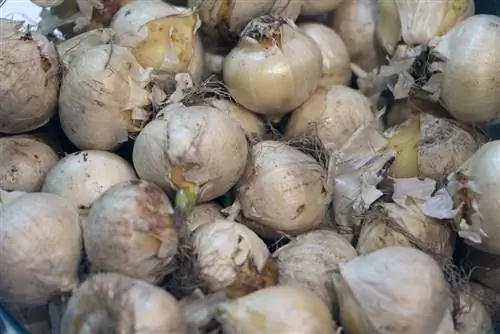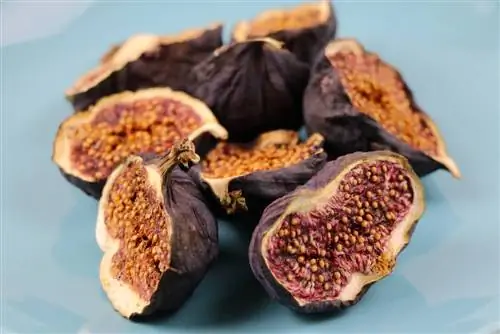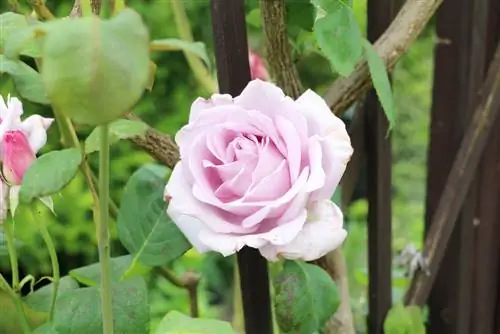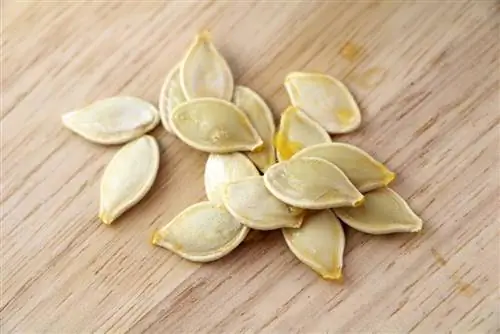- Author admin [email protected].
- Public 2023-12-17 03:39.
- Last modified 2025-01-24 12:45.
Properly dried and preserved for a long time, you can enjoy rose petals and rose petals for many years. The basis is optimal drying. In order to preserve the scent and color over the long term, there are various preservation options available to you. To do this, you need simple tools that are available in almost every well-equipped household, as well as a little patience. The following guide explains in detail how you should proceed and which methods are available to you.
Rose Types
All types of roses are suitable for giving rose petals and/or rose flowers an immortality by drying them. Here the skill lies primarily in the right time when the leaves or flowers are removed. If you want the scent of roses to fill the environment in the long term, it is advisable to only select strongly scented rose varieties. These include, for example:
- Shrub rose “Rhapsody in Blue”
- Bedding rose “Sunlight Romantika”
- Small shrub rose “Pink Roadrunner”
- Portland rose “Rose de Resht”
- Rosa rugosa “Agnes”
Harvest time
If you have your own roses in your garden, you are of course tied to the flowering period when it comes to harvesting leaves and flowers. As a rule, most rose varieties bloom in June, although there are some that have their first main bloom in May or July. In order not to deprive the garden of the visual splendor of blooming roses, you should take a look at the flowers every day from the moment they bloom, especially on hot and/or rainy days. This is the only way you can remove fresh, fragrant and colorful flower specimens from the rose in time before the wilting phase begins.
It is advisable not to wait for the leaves or entire flowers to fall off, but to time the exact moment and harvest them while they are still attached to the plant. Under no circumstances should you pull the leaves before the flowers open, as this usually means that the rose will not produce any further shoots or buds that year.
If you find a flower that has been in the budding stage for three or four days, it is the perfect time to harvest. This should always be done shortly before full flowering.
Bouquet
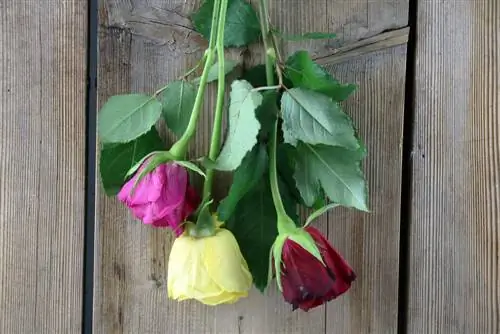
If you want to use the flowers of a rose from a purchased bouquet, they are usually a little open. Since they wilt more quickly than when planted in soil, you should start cutting them off after two days at the latest so that you can cut them off shortly before the flowers fully open.
Detach
Don't just tear off the leaves or whole flowers, cut them. If a whole branch is to be dried, it is cut off above the second leaf base. The prerequisite is that there are no other buds on this branch that would die when closed. If only the rose petals or the flower are needed, cut off the flower stem directly below the flower. Each petal can then be removed directly from the flower.
drying
In order to make the leaves of roses last for a long time, they must be dried properly. There are various options available to you:
Book drying
The best-known way to dry rose petals is with the book. They are placed between the book pages and the book is then closed. It is important that either a clean, absorbent kitchen paper or, even better, a blotter is placed under and over the sheet. This allows the moisture to escape optimally from the leaves and also does not dirty the book pages.
But be careful:
The sheets must not lie on top of each other.
The absorbent paper should be changed once a week or the sheets should be moved in position. After about three weeks, the rose petal should be dry at room temperature. This drying method has the advantage that the rose petals are dried from both sides at the same time.
However, they lose their natural curvatures and emerge completely pressed smooth after drying. That's why this process is more suitable, for example, for decorating letters with roses or for picture frames. The same applies to drying flowers.
Free-drying
In order to maintain the individual shape or curvature, drying without pressing is recommended. To do this, spread the rose petals and/or flowers either on a grid or on kitchen paper so that they do not overlap. The cooler the ambient temperature, the slower they dry. The ideal places are, for example, the boiler room or a sheltered sun spot on the terrace or balcony.
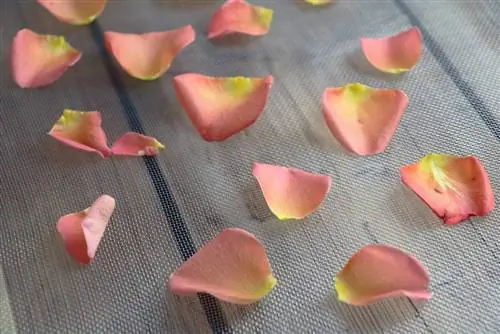
If paper is used to absorb moisture, it must be replaced every three days or the items to be dried should be relocated so that they are fully absorbent again and no mold forms.
During grid drying, air circulates underneath so that no mold can form. With both methods, the rose petals and leaves should be turned over regularly. This allows them to dry evenly on both sides. In warm temperatures, a turn is possible after about three or four hours.
Tip:
Since all kinds of crawling insects are often picked up during the harvest, it is advisable to collect the rose petals in an airtight bag before drying. After a few minutes, open the bag again and see how the crawlers run away as they pour out the flowers.
Dry s alt/silica gel and detergent
Instead of blotting paper, newspaper and kitchen paper, you can also use special dry s alt, silica gel or dry detergent. Silica gel is crystal-like beads that are packaged in small bags, often found in shoe boxes or on leather clothing to protect against moisture.
This drying process has the advantage that drying is usually quicker because it specifically extracts the moisture from the rose petal or leaf. In addition, it can be used multiple times, allows the original deformation to remain and at the same time improves durability.
For drying, depending on the amount of queen flowers and leaves to be dried, choose a sealable container and cover the bottom with drying s alt or silica gel. The flower parts are laid out on top and covered with another layer of s alt or silica gel. The vessel is then closed for around three to four days.
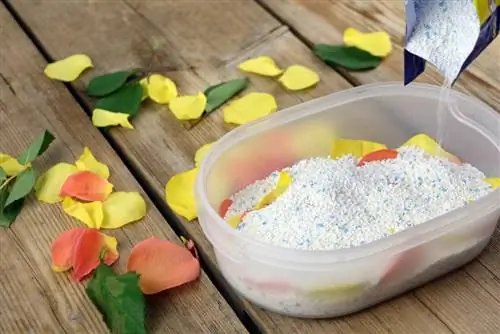
With the dry s alt variant, you can optimally see how the moisture is absorbed as the s alt increasingly takes on the color of the leaves. If the color contrast remains the same, the drying process is complete and the container can be opened.
Tip:
You can quickly dry the dry s alt and the silica gel again for the next use. To do this, place the s alt in the microwave and the silica gel dries in a hot oven in a few minutes.
Oven drying
The oven technique is a quick and highly recommended drying method. To do this, sprinkle the baking tray with sand, then spread the petals on it and then put the baking tray in the oven at 40 degrees. The drying process should be finished after about 30 minutes.
The advantage of oven drying is not only the time and effort saved, but the quick drying also causes the petals to bulge on the flower bulb. Used especially as potpourri, this offers a chic look and underlines the naturalness. In addition, the minimal heat protects the fragrance aroma and remains much more intense in the dry substance.
Microwave drying
You can achieve similar results when drying using a microwave. In addition to the rose parts and a microwave, you will need the following accessories:
- Absorbent kitchen paper
- Two microwave-safe plates
- Alternative: two fireproof ceramic tiles
Instructions:
- Cover/line the tile or plate with a layer of kitchen paper
- Distribute rose petals and, if necessary, rose petal heads
- Place a layer of kitchen paper on top
- Cover with the second plate or tile
- Put in the microwave
- Heat between 40 seconds and 1.5 minutes depending on the wattage
- Remove and drying is done!
- Rose bouquet drying
Not only rose petals and leaves can be dried, but also entire rose bouquets. The ones that are best suited are those that were cut early and where the flowers have only just opened slightly. Cut the stems diagonally and place the rose bouquet in a vase with fresh water mixed with glycerin in a 1:1 ratio. You can get glycerin in any pharmacy.
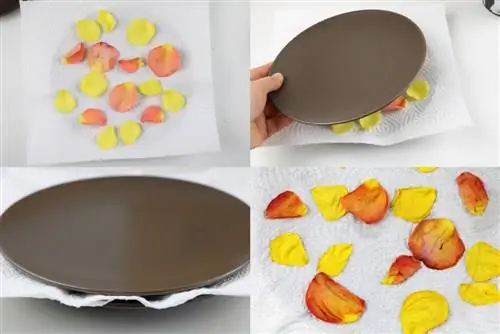
After about two days, take the rose bouquet out of the water, divide it into a maximum of eight stems and put them together into a bundle. If there were more rose stems, drying would be more difficult and an even and complete loss of moisture would not be guaranteed.
Now hang the individual bundles upside down. A cool, dry and airy place should be chosen as the drying place. For example, storage floors or a barn where no sun shines on the rose bundles are ideal.
Depending on the type of rose and flower size, the drying time lasts between four and six days. The bundles can then be removed and placed individually or put together again in a flower vase without water. Complete drying is complete after around four weeks.
Durability
Rose petals and rose petals as well as bouquets last significantly longer if they receive some kind of preservation. This can be done either with clear varnish or with hairspray. Simply spray it on after the drying process is complete. Make sure that you cover everything well with the clear varnish or hairspray so that you can create an even film on the flowers, leaves or the entire bouquet of roses.
Both variants provide roughly the same durability, although gloss clear varnish can also add a slightly shimmering brilliance. If you repeat the preservation every few months, the dried roses will retain their beauty for years at best. By the way, extending the shelf life with hairspray has no effect.
Only in the first few hours after spraying will the smell of the spray spread, but the rose scent will prevail.
Conclusion
Rose petals, rose petals and rose bouquets can be dried professionally using the simplest means and without much effort. With the drying methods and preservation described here, you can use the queen of flowers for numerous decorative purposes and as a scent oasis in the long term.


